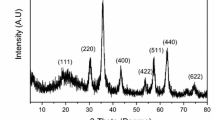Abstract
To improve the adsorption properties of chemically modified chitosan, the chelating resin of salicylal chitosan Schiff bases was prepared by the template cross-linking method using Cu(II) as template ion and ethylene glycol bisglycidyl ether as cross-linking agent in microwave, and was characterized by IR. The adsorption capacity and selectivity coefficient of the chemically modified chitosan for Cu(II), Fe(III) and Zn(II) were investigated, respectively. The results show that the adsorption capacity of the resin 2.73 mmol/g for Cu(II) is bigger than that for other two metal ions, 0.22 mmol/g for Fe(III), and 0.42 mmol/g for Zn(II), and the selectivity coefficients are as follows: K Cu(II)/Fe(III)=12.4, K Cu(II)/Zn(II)=6.5.
Similar content being viewed by others
References
Inouc K, Baba Y, Yoshizuka K. Adsorption of metal ions on chitosan and cross-linked copper (II) complexed chitosan [J]. Bull Chem Soc Japan, 1993, 36(26): 1 915–2 921.
QU Rong-jun, SUN Yan-zhi, WANG Chun-hua, et al. The synthesis and adsorption properties of chitosan resins supported by SiO2 for heavy metal ion [J]. Ion Exchange and Adsorption, 1999, 15(4):317–324.
QU Rong-jun, LIU Zhu-qing, WANG Chun-hua, et al. Synthesis and adsorption characterization of carboxymethyl crosslinked chitosan resin [J]. Acta Scientiae Circumstantiae, 1997, 17(1):121–125. (in Chinese)
WANG Xiao-hong, MA Jian-biao, HE Bing-lin. Properties and application of chitin, chitosan and their derivaties [J]. Journal of Functional Polymers, 1999, 12(2)192–202. (in Chinese)
Matsumura S, Yokochi E, Winursito I, et al. Preparation of novel biodegradable polyampholytepartially dicarboxylated chitosan [J]. Chemistry Letters, 1997, 28(3): 215–216.
YU Yi-hua, HE Bing-lin. Chemical modification for chitin and chitosan [J]. Polymer Bulletin, 1997, 26(4):232–237.
Katsuoshi I. Application of complex types of chemistry modified chitosan for separation /purification /concentration of metals[A]. Proceedings of the Third International Conference on Hydrometallurgy [C]. Kunming, 1998.
Katsutoshi I, Hiroyuki H, Youshi I, et al. Adsorption of metal ions on gallium(III)-templated oxide type of chemically modified chitosan [J]. Separation Science and Technology, 1996, 31(16):2 273–2 285.
David R, Baghurst D, Michael P, et al. Application of microwave dielectric loss heating effects for the rapid and convenient synthesis of organometallic compounds [J]. Journal of Organometallic Chemistry, 1989, 23(368):C43-C45.
Mijovié J, WiJaya J. Comparative calorimetric study of epoxy cure by microwave vs thermal energy [J]. J Macromolecules, 1990, 23(15):3 671–3 674.
Raymond J G, Terry L B, Scott M D. Application of commercial microwave ovens to organic synthesis [J]. Tetrahedron Letter, 1986, 27(41):4 945–4 948.
Gedye R, Smith F, Westaway K. Microwaves in organic and organometallic synthesis [J]. J Microwave Power Electromagn Energy, 1991, 26(1):3–16.
David R B D, Michael P M. Design and application of reflux modification for the synthesis of organometallic compounds using microwave dielectric loss heating effects [J]. Journal of Organometallic Chemistry, 1990, 24(384):C57-C60.
Limousia C, Cléophax J, Petit A, et al. Solvent-free synthesis of decyl D-glycopyranosides under focused microwave irradiation [J]. J Carbohydrate Chemistry, 1997, 16(3):327–324.
Quang L V, Albert G. Microwave curing of epoxy resins with diaminodiphenylmethane (I): general features [J]. Eur Polym J, 1987, 23(10):777–780.
CAO Zuo-ying, GE Hua-cai, LAI Sheng-li. Studies on synthesis and adsorption properties of chitosan cross-linked by glutaraldehyde and Cu(II) as template under microwave irradiation [J]. Eur Polym J, 2001, 38(37): 2 141–2 143.
Author information
Authors and Affiliations
Corresponding author
Additional information
Foundation item: Project (69671022) supported the National Natural Science Foundation of China
Rights and permissions
About this article
Cite this article
Cao, Zy., Wei, Qf. & Zhang, Qx. Template synthesis and adsorption properties of chitosan salicylal Schiff bases. J Cent. South Univ. Technol. 11, 169–172 (2004). https://doi.org/10.1007/s11771-004-0035-0
Received:
Accepted:
Issue Date:
DOI: https://doi.org/10.1007/s11771-004-0035-0




